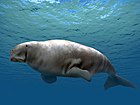Eotheroides
| Eotheroides | |
|---|---|

| |
| Eotheroides sp. in Artis, Amsterdam .
| |
| Scientific classification | |
| Kingdom: | |
| Phylum: | |
| Class: | |
| Order: | |
| Family: | |
| Genus: | Eotheroides Trouessart, 1905
|
| Species | |
Eotheroides is an extinct
Based on
Species

The type species, E. aegyptiacum, is known from the
Several other species have been named, including E. babiae from India,[4] E. majus, E. clavigerum and E. sandersi from Egypt,[5][6] and E. waghapadarensis, also from India.[7] E. majus was based on a single upper molar, which was never catalogued and is now lost;[6] it has been considered a senior subjective synonym of E. aegyptiacum.[8]
Paleobiology

The teeth of Eotheroides were relatively unspecialized compared to those of extant sirenians, which are reduced as an adaptation for feeding on sea grass. The upper molars of E. lambondrano are considerably longer and wider than those of E. aegyptiacum, suggesting that they were less specialized.
References
- ^ a b c Gingerich, P. D.; Domning, D. P.; Blane, C. E.; Uhen, M. D. (1994). "Late Eocene sea cows (Mammalia, Sirenia) from Wadi Al Hitan in the Fayum Basin, Egypt". Contributions from the Museum of Paleontology. 29 (2). University of Michigan: 41–67.
- S2CID 59466434.
- ^ a b "Ancient Pygmy Sea Cow Discovered". Science Daily. 18 December 2009. Retrieved 18 December 2009.
- S2CID 86682899.
- ^ Zdansky, O. (1138). "Eotherium majus sp. n., eine neue Sirene aus dem Mitteleozän von Ägypten". Palaeobiologica. 6: 429–434.
- ^ hdl:2027.42/94568.
- ^ Das, D. P.; Basu, P. K. (1994). "Study of Palaeogene marine mammals of Kachchh, Guarat". Geological Survey of India. 127 (2): 5.
- ^ Gingerich, P. D. (1992). "Marine Mammals (Cetacean and Sirenia) from the Eocene of Gebel Mokattam and Fayum, Egypt: Stratigraphy, Age, and Paleoenvironments". Contributions from the Museum of Paleontology. 30. University of Michigan: 1–84.
Further reading
- Marine Mammals: Evolutionary Biology by Annalisa Berta, James L. Sumich, and Kit M. Kovacs
- The Beginning of the Age of Mammals by Kenneth D. Rose
- Classification of Mammals by Malcolm C. McKenna and Susan K. Bell

